Nepal Tourist Places
From the majestic peaks of the Everest and Annapurna regions to the spiritual sanctuaries of Lumbini and Kathmandu Valley, Nepal promises unforgettable experiences for every traveler.
From the majestic peaks of the Everest and Annapurna regions to the spiritual sanctuaries of Lumbini and Kathmandu Valley, Nepal promises unforgettable experiences for every traveler.
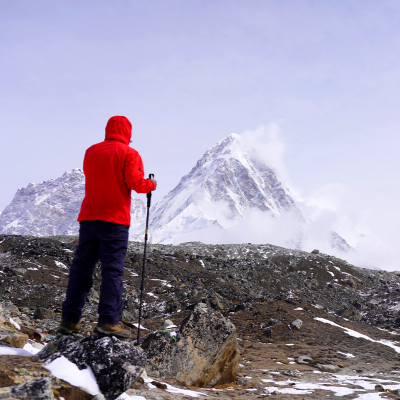
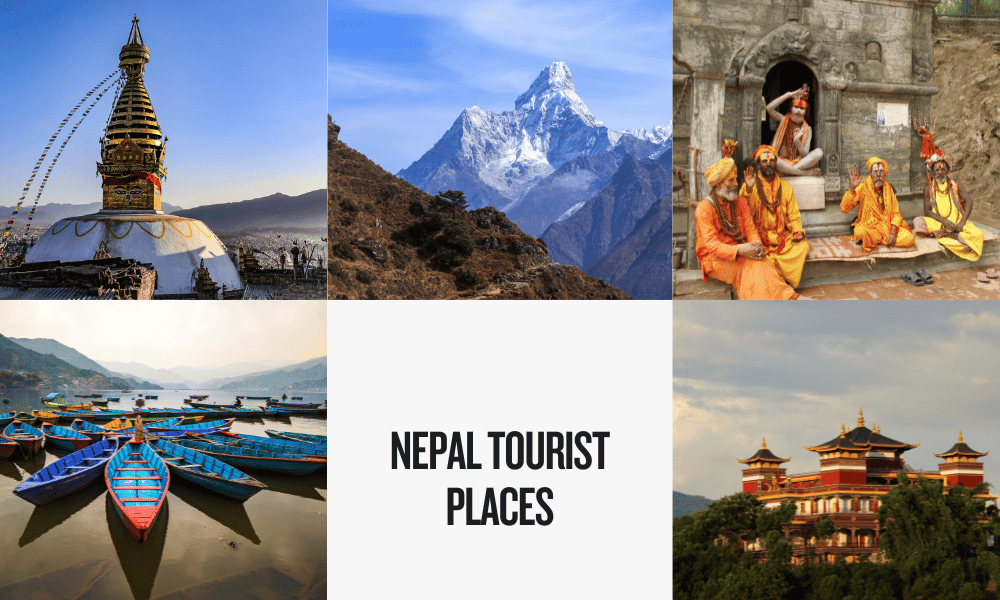
Nepal is a country with a lot of different landscapes, cultures, and a long past. It is located between the tall peaks of the Himalayas and the steamy jungles of the Indian plains. This landlocked country is in South Asia. It is 147,181 square kilometers big and shares borders with China to the north and India to the south, east, and west.
Nepal has a very diverse landscape. It has some of the world's highest mountains, like the majestic Mount Everest, as well as subtropical lowlands in the Terai area. This varied environment is home to an amazing range of plants and animals, which makes it a nature lover's paradise.
Nepal's variety of cultures is just as amazing. There are more than 100 ethnic groups and subgroups in the country, and each has its own customs, languages, and practices. The Sherpas, Newars, Tamangs, Tharus, and Gurungs, among other groups, are well-known for their ethnicity. This diverse mix of cultures has led to a wide range of art, architecture, food, and festivals that are enjoyed with a lot of passion and energy all year long.
Religion is a big part of how the people of Nepal live their lives. Hinduism is the most common religion, followed by Buddhism. There are many sacred places and temples all over the country. The fact that these two major religions and other fringe religions can live together peacefully shows how tolerant and peaceful religions are in Nepal.
Nepal is a fascinating place to visit because it has a unique mix of different landscapes, lively cultures, and a long past. This makes it a great place for people who want to have a truly immersive and unforgettable experience.
Nepal's economy is built on tourism, which is a key part of its GDP, job market, and foreign exchange gains. Over the years, the tourism industry has grown steadily, drawing people from all over the world who are looking for excitement, cultural experiences, and natural beauty.
Contribution to GDP: As of 2021, tourism is one of Nepal's biggest businesses, making up about 7–8% of the country's GDP. Tourism's direct and indirect effects on the economy include money spent on lodging, food and drinks, transportation, entertainment, and other services linked to travel.
Opportunities for work: The tourism business provides a lot of jobs for the people who live there. The tourism industry is thought to directly and indirectly hire around one million people. This includes work in hotels, restaurants, travel agencies, airlines, and companies that offer trekking and adventure sports. The industry also helps local artists, shop owners, and other small businesses make a living, which helps the country's economy grow as a whole.
Earnings in foreign currency: Tourism is one of the main ways Nepal makes money in foreign currency. Before the pandemic, this sector brought in more than a billion US dollars each year in foreign exchange, which was a key part of paying for imports and keeping the country's balance of payments in good shape.
Infrastructure improvement: As the tourism business has grown, the country's infrastructure has gotten better. This means building roads, airports, information networks, and other important infrastructure. The government has also put a lot of effort into keeping cultural and nature heritage sites in good shape and letting people know about them. This makes sure that these places are still interesting to tourists and keeps them around for future generations.
Poverty Reduction: Tourism in Nepal helps to reduce poverty by providing jobs, bringing in money, and supporting community development projects in the area. Tourism brings in money that is often used to pay for schools, hospitals, and other important services in rural areas.
Nepal's economy depends on tourism because it helps to grow GDP, create jobs, bring in foreign currency, improve infrastructure, and reduce poverty. Nepal's government and private industry are still working to promote responsible and sustainable tourism in order to protect Nepal's unique cultural and natural heritage and get the most money out of it.
In this blog post, we want to give readers an in-depth look at Nepal's top tourist spots, giving them all the information they need to plan a trip to this beautiful and diverse country. We will go into detail about the must-see places, focusing on the unique things and experiences that each one has to offer.
Our trip will take us through the busy city streets of the Kathmandu Valley, where we will learn about the rich history and architectural wonders of old towns like Kathmandu, Patan, and Bhaktapur. Then we will go to Pokhara, a beautiful city known for its calm lakes, beautiful mountain views, and exciting action sports.
Nature lovers will enjoy our trip to Chitwan National Park, which is a home for wildlife and a chance to learn about the native Tharu culture. We will also show you the beautiful trekking routes in the Annapurna and Everest regions, which offer a wide range of culture experiences and breathtaking views.
If you want to find spiritual enlightenment, we will take you to Lumbini, where Lord Buddha was born, and show you around its holy sites and different Buddhist temples. Lastly, we will go to the Langtang region, which has traditional Tamang villages, holy lakes, and trekking paths that are not as well known.
Throughout this piece, we will talk about how important responsible and sustainable tourism is. We will encourage visitors to respect local customs, protect the natural environment, and help local communities. By showing people the best places to visit in Nepal, we hope to encourage them to go on their own Nepalese adventures and experience the country's rich culture, beautiful scenery, and friendly people.
The Kathmandu Valley, which includes the busy capital city of Kathmandu and the nearby towns of Patan and Bhaktapur, is a treasure trove of cultural and historical sites. There are several UNESCO World Heritage Sites in the valley, such as the famous Durbar Squares. These sites show a wide range of building styles and artistic traditions. Spiritual people can find peace at the renowned Swayambhunath Stupa and Pashupatinath Temple. Boudhanath shows how Buddhist culture is alive and well. With its many temples, castles, and traditional Newari culture, the Kathmandu Valley is a must-see for tourists who want to learn more about Nepal's rich history and culture.
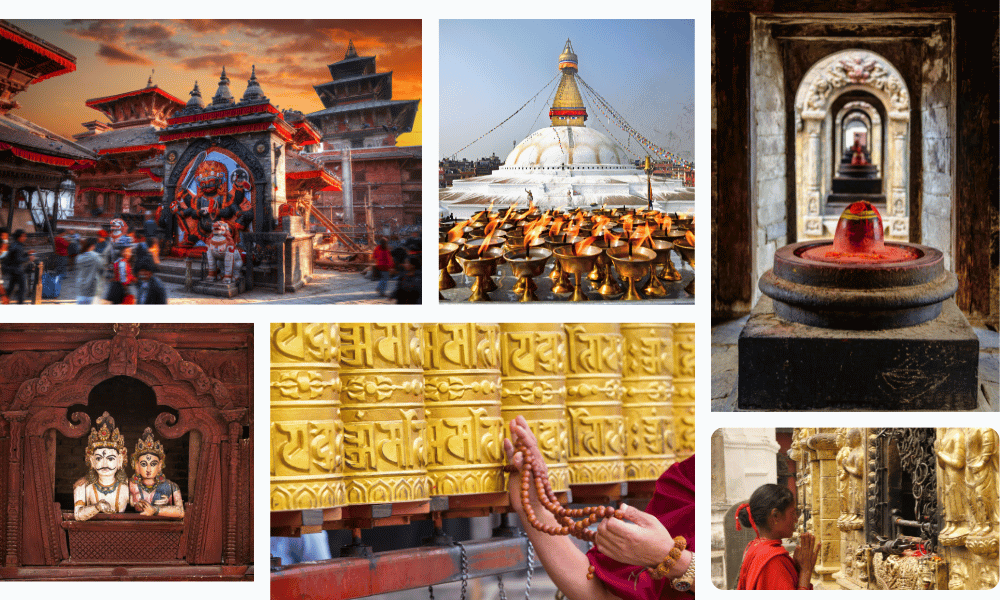
Kathmandu Durbar Square is a UNESCO World Heritage site that is in the middle of the city. It is also called Basantapur Durbar Square or Hanuman Dhoka. The square is a live museum of old buildings. It has a beautiful collection of temples, palaces, courtyards, and statues from the 12th to the 18th centuries.
The Malla and Shah Kings, who ruled over the city, used Durbar Square as their royal place of power. This makes it an important part of the city's history. Traditional Nepalese buildings like the Hanuman Dhoka Royal Palace, which is home to the King Tribhuvan Memorial Museum and the Mahendra Museum, can be seen all around the area.
Some of the most important building features of Durbar Square are:
The impressive Taleju Temple has three roofs and is dedicated to the goddess Taleju Bhawani, who was the patron saint of the Malla Kings.
Kasthamandap is a wooden house that is thought to have been made from the wood of a single tree. It is also how the city of Kathmandu got its name.
Kumari Ghar is the home of the live goddess Kumari, who is thought to be the goddess Taleju in the form of a young girl.
Related Article: Kathmandu Durbar Square
Swayambhunath Stupa is one of the oldest and most important Buddhist sites in Nepal. It is on top of a hill with a view of the Kathmandu Valley. Swayambhunath is known as the "Monkey Temple" because monkeys live there. It is a symbol of peace between Buddhism and Hinduism, and people from both religions come to worship there.
Swayambhunath Stupa is spiritually important because it has been a pilgrimage place for both Buddhists and Hindus for a long time. King Manadeva, who ruled in the 5th century, is said to have made the stupa to make up for his sins. On top of the golden tower of the stupa are the all-seeing eyes of Lord Buddha, which are thought to keep an eye on the valley and its people.
When you go to Swayambhunath Stupa, you can see the whole Kathmandu Valley. This makes it a famous spot for photographers and tourists who want to see the city from above. There are also a number of churches, shrines, and monasteries in the complex, which gives an interesting look into the spiritual life of the people of Nepal.
Related Article: Swayambhunath Stupa
Patan, also called Lalitpur, is one of the three royal towns in the Kathmandu Valley. It is just south of the Bagmati River. Patan's Durbar Square is a UNESCO World Heritage Site with a stunning collection of temples, palaces, and courtyards that show off the artistic brilliance of the Malla Kings, who ruled the city from the 14th to the 18th centuries. It is known for its beautiful Newari craftsmanship and rich cultural history.
Some of the most important pieces of history and architecture in Patan Durbar Square are:
Patan Royal Palace is a beautiful palace complex that was once home to the Malla Kings. It is now home to the Patan Museum, which has displays of traditional Nepalese art and artifacts.
Krishna Mandir is a beautiful temple made of stone that is dedicated to Lord Krishna. It has intricate paintings of scenes from the Hindu epics Ramayana and Mahabharata.
The Bhimsen Temple is a three-story building that is dedicated to Bhimsen, the god of business and trade. It has elaborately carved wooden windows and a unique balcony.
The Vishwanath Temple is a temple for Lord Shiva. It has beautiful stone images of different Hindu gods and a large statue of Nandi, Shiva's celestial bull.
Related Article: Patan Durbar Square
The Golden Temple, also called Hiranya Varna Mahavihar, is a Buddhist temple from the 12th century that is close to Patan Durbar Square. This three-story pagoda-style temple has gilded metal plates and intricate wood carvings that give it a distinctive golden look that draws both tourists and people who want to worship there.
The Golden Temple is one of a kind because its architecture is a mix of Buddhist and Newari design elements that work well together. The complex of monasteries is decorated with intricate wood and metal carvings that show scenes from the life of Buddha and different mythical animals from the Buddhist pantheon. In the center of the temple's courtyard is a shrine to Lord Buddha, which is ringed by smaller stupas and statues of other gods.
The Golden Temple is a beautiful example of Nepalese art and building. It is also a place where Buddhists come to worship and learn. Visitors can watch the resident monks perform traditional routines, prayers, and ceremonies, which immerses them in the monastery's rich cultural history and spiritual atmosphere.
Bhaktapur, also called Bhadgaon or Khwopa, is an old city about 13 kilometers east of Kathmandu. It is a well-preserved city that shows the traditional Newari culture, art, and buildings. The temples, palaces, and monuments in the UNESCO World Heritage Site Bhaktapur Durbar Square show the artistic heritage of the Malla Kings, who ruled the city from the 12th to the 15th centuries.
Some of the most interesting things about Bhaktapur Durbar Square are:
Nyatapola Temple is a pagoda-style temple with five stories that is dedicated to the goddess Siddhi Lakshmi. It is well-known for its impressive height, elaborate wood carvings, and huge statues of guardians.
The 55-Window Palace, the Golden Gate, and the National Art Gallery, which has traditional Nepalese paintings, sculptures, and objects, are all part of the Bhaktapur Royal Palace, which was once the home of the Malla Kings.
The Dattatreya Temple is a one-of-a-kind temple made out of the wood of a single tree. It is dedicated to the Hindu trinity of Brahma, Vishnu, and Shiva and has beautiful wood carvings of gods and mythical animals.
Visitors can learn about traditional Newari culture and art by walking through the small streets, courtyards, and workshops where potters, wood carvers, and metal workers make beautiful pottery, wood carvings, and metal works. Bhaktapur is also known for its Juju Dhau, which is a delicious and smooth yogurt that food lovers must try.
Related: Article: Bhaktapur Durbar Square
The Changu Narayan Temple is the oldest temple in Nepal. It is about 4 kilometers north of Bhaktapur, on a hilltop with a view of the Kathmandu Valley. It was built in the 4th century during the Lichhavi time. This UNESCO World Heritage Site is a great example of early Nepalese temple building. It is dedicated to Lord Vishnu and has reliefs made of stone and wood that show Hindu gods and stories from mythology.
The Changu Narayan Temple is important not only because of its architecture, but also because of its history and religion. The temple complex is home to a number of important writings, sculptures, and objects that tell us a lot about the history and culture of ancient Nepal. The Garuda Dhvaja, a stone pillar built by King Manadeva in the 5th century, is one of the most important historical pieces found at the site.
The Changu Narayan Temple is surrounded by a quiet forest and is a peaceful and spiritual place to get away from the busy city. People can see a wide view of the valley, take part in traditional ceremonies and customs, and learn about the temple's long history and cultural heritage.
The Pashupatinath Temple is one of the most important Hindu religious sites in Nepal and the whole world. It is on the banks of the holy Bagmati River. This temple complex is a UNESCO World Heritage Site and is dedicated to Lord Shiva. Every year, thousands of pilgrims and tourists come to pray, perform practices, and soak up the spiritual atmosphere.
The Pashupatinath Temple is a beautiful piece of architecture. It was built in the traditional Nepalese pagoda style and has beautiful wood and stone carvings. The main temple has a golden roof, silver-plated doors, and a holy lingam, which is where worshippers focus their attention.
Not only is the temple complex important because of its religious and architectural value, but it is also important because it helps to keep Nepal's cultural customs alive. Throughout the year, visitors can see different rituals, ceremonies, and holidays, such as the Maha Shivaratri festival, which draws millions of devotees from all over the world.
Related Article: Pashupatinath Temple
The Boudhanath Stupa is about 11 km northeast of Kathmandu. It is one of the biggest and most important Buddhist pilgrimage places in Nepal and the world. This UNESCO World Heritage Site is a sign of Nepal's rich Buddhist culture. It shows the Buddha's awakened mind and the way to spiritual awakening.
The Boudhanath Stupa is a beautiful piece of architecture. It has a huge white dome on top of a golden tower with the eyes of Lord Buddha on it. The area around the stupa is full of temples, shops, and restaurants. This shows how important Tibetan Buddhism is in the area.
People can walk around the stupa while turning the prayer wheels and saying mantras to gain merit and clear their thoughts. The Boudhanath Stupa is not only a place of worship, but also a place where Buddhist monks and women study rituals, philosophy, and meditation. Buddhist festivals like Losar and Buddha Jayanti bring the area to life. These festivals are marked with a lot of passion and devotion.
Related Article: Boudhanath Stupa
Get in touch with our experts right away and finalize an experience!
About UsPokhara is a beautiful city on the shores of Phewa Lake. It is the entrance to the Annapurna Region and a great place to experience both nature and culture. People can take boats out on the calm lake, walk around the busy area near the lake, or go to the World Peace Pagoda, which is a symbol of peace and faith. Pokhara is also a center for outdoor sports like paragliding. From Sarangkot, you can get amazing views of the Annapurna range while having a thrilling time paragliding. Pokhara is a must-see for any visitor to Nepal because of its beautiful scenery, lively atmosphere, and wide range of things to do.
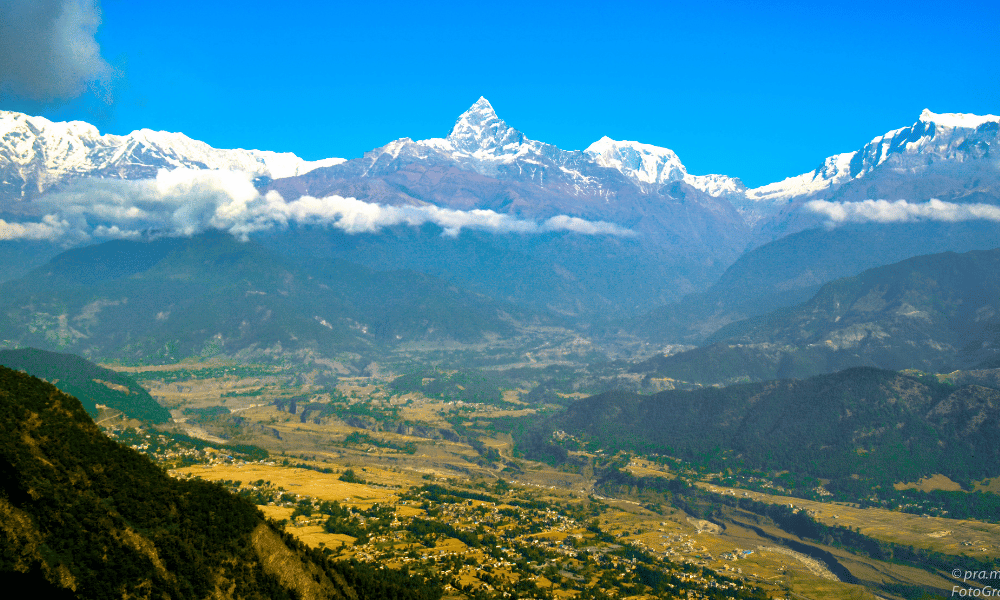
Phewa Lake, which is also called Fewa Lake, is Nepal's second biggest lake and the heart of Pokhara's charm. The lake is at the base of the Annapurna mountain range. It is a peaceful and beautiful place to relax, go fishing, or eat.
Visitors can rent a boat or go on a guided tour to experience the calm waters of Phewa Lake and see the iconic reflection of Machhapuchhre in the water. On the eastern shore, which is called Lakeside, there are many restaurants, cafes, and shops where people can eat wonderful food from around the world and watch the sunset over the lake.
The World Peace Pagoda, which is also called Shanti Stupa, is a beautiful white structure that stands on a hill and looks out over Phewa Lake. This pagoda was built by Buddhist monks in Japan. It is one of 80 peace pagodas around the world that were built to support peace among all people and religions.
The World Peace Pagoda has amazing views of the Pokhara Valley, Phewa Lake, and the Annapurna mountain range, which makes it a popular place for photos and meditation. The pagoda has beautiful statues of Lord Buddha and intricate carvings that show what he taught about peace and how to live by those ideals.
Sarangkot is a beautiful town on a hilltop about 11 kilometers from Pokhara. It is known for its amazing views of the Annapurna range at sunrise and its exciting paragliding. At an altitude of 1,600 meters, Sarangkot gives sweeping views of the snow-capped peaks of Annapurna, Dhaulagiri, and Machhapuchhre, as well as the beautiful Pokhara Valley and Phewa Lake.
People can go on a walk to the Sarangkot viewpoint early in the morning to see the magical sunrise, which turns the mighty mountains pink and orange. If you want to get a rush, Sarangkot is a great place to try tandem paragliding. You can fly high above the valley with an experienced pilot and take in the amazing views of the Himalayas and the lake below.
Chitwan National Park is a UNESCO World Heritage Site in Nepal. It is in the Terai area, which is known for its one-horned rhinoceros and Bengal tigers, both of which are endangered. Visitors can do a variety of things in the park, like go on wildlife safaris, watch birds, or walk through the jungle. This gives them a full view of Nepal's rich biodiversity. Chitwan National Park has a lot of natural sights, but it also has cultural experiences, like meeting the native Tharu people and learning about their unique way of life. The park is a great place for people who love nature and want a real and exciting wildlife journey.
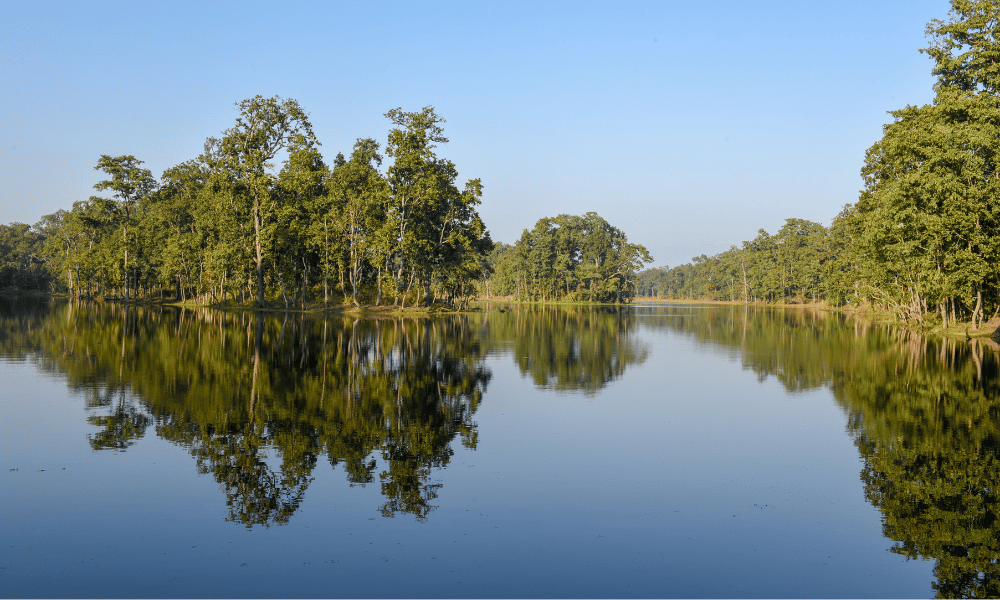
Chitwan National Park is the first national park in Nepal. It opened in 1973 and is now a UNESCO World Heritage Site. The park is 932 square kilometers big and is home to many different kinds of plants and animals, some of which are threatened, like the Bengal tiger, the one-horned rhinoceros, and the gharial crocodile.
Chitwan National Park's main draw is its wildlife safaris, which give tourists the chance to learn about the park's rich ecosystem and see rare animals in their natural habitat. There are guided car safaris and elephant-back safaris that let you get up close and personal with the wildlife in the park. Visitors can also walk around the park with expert guides who can tell them about the plants, animals, and ecosystems in the area.
Chitwan National Park is a paradise for people who like to watch birds. There are more than 500 kinds of birds there, some of which are rare or endangered. The grasslands, forests, and marshes in the park make it a great place for a wide range of resident and migrating birds, such as the critically endangered Bengal florican, the vulnerable lesser adjutant, and the almost-threatened white-rumped vulture.
There are birdwatching tours run by knowledgeable naturalists who can help people find and name the different species in the park. The best time to watch birds in Chitwan National Park is from October to March, when the birds are migrating. During this time, the park is full of bright colors and melodic bird calls.
The Tharu are an ethnic group that has always lived in the Terai area of Nepal. They have their own culture, language, and way of life, which have developed over hundreds of years of living in harmony with their environment. When you go to Chitwan National Park, you can experience Tharu culture and learn about their habits, beliefs, and traditional ways of doing things.
Visitors can take part in cultural events that show traditional Tharu songs and dances. They can also visit local villages to see how people live, how they farm, and how they built their homes in the past. The Tharu Cultural Museum in the park gives tourists important information about the community's history, culture, and way of life. This helps them understand and appreciate the region's rich cultural heritage.
The Annapurna Region in central Nepal is known for its wide range of landscapes, from green valleys to dry mountains. Trekkers of all skill levels can enjoy a wide range of trekking experiences there. The Annapurna Base Camp Trek is a beautiful trip through a variety of landscapes, and the Poon Hill Trek gives you a great view of the Annapurna range. The Mardi Himal Trek is an exciting option for those who want to take a less-trodden path, while the sacred Muktinath Temple draws spiritual travelers. With its beautiful mountain views and rich local customs, the Annapurna Region is a great place for trekkers who want to experience both nature and culture.
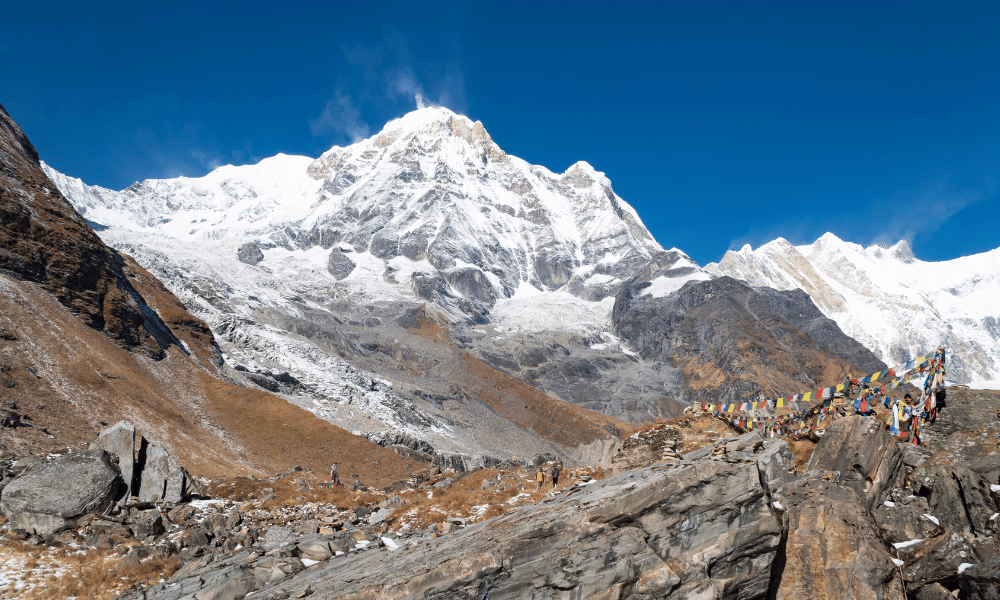
The Annapurna Base Camp Trek, also called the Annapurna Sanctuary Trek, is a popular and rewarding trip that takes trekkers through a variety of landscapes, such as terraced rice fields, lush rhododendron forests, and barren high-altitude deserts. The walk ends at the Annapurna Base Camp, which is at an elevation of 4,130 meters and has amazing views of the Annapurna massif, including the 10th highest mountain in the world, Annapurna I.
The Annapurna Base Camp Trek usually takes between 7 and 12 days and is good for people of all fitness levels. It gives trekkers a unique look at Nepal's natural beauty and rich cultural history.
The Ghorepani Poon Hill Trek, which is also called the Poon Hill Trek, is a short and easy trek in the Annapurna area that gives you amazing views of the Himalayas. The trek usually takes between 4 and 6 days and goes through charming Gurung and Magar towns, rhododendron forests, and terraced farmlands.
The sunrise view from Poon Hill (3,210 meters) is the best part of the walk. From there, you can see the Annapurna and Dhaulagiri mountain ranges, including the famous peaks of Annapurna South, Machhapuchhre, and Dhaulagiri.
The Mardi Himal Trek is a less well-known and less-explored trekking route in the Annapurna area that gives adventure seekers a chance to get off the beaten path. This easy hike usually takes between 5 and 7 days to finish. It goes through lush forests, traditional towns, and high-altitude pastures.
The walk ends at the Mardi Himal Base Camp (4,500 meters), which has amazing views of the Annapurna massif, including the tall peaks of Machhapuchhre, Annapurna South, and Hiunchuli. The Mardi Himal Trek is great for people who want to go climbing in the Himalayas in a quieter, more private way.
The Muktinath Temple is a holy pilgrimage place for both Hindus and Buddhists. It is in the Mustang district at an elevation of 3,710 meters. People think that the temple, which is dedicated to Lord Vishnu, is a place where they can be saved from the cycle of birth and death.
The temple complex has a main shrine in the shape of a pagoda, 108 water spouts, and an eternal flame that is kept burning by natural gas. These things represent the holy elements of water, earth, and fire. People often visit Muktinath Temple as part of the Annapurna Circuit Trek or the Jomsom-Muktinath Trek. It offers a unique mix of natural beauty, spirituality, and cultural history for both trekkers and pilgrims.
The Everest Region is in the northeast of Nepal. It has some of the most famous and difficult hiking routes in the world. People looking for adventures come from all over the world to this area because of its beautiful high-altitude scenery and majestic peaks, like Mount Everest, which is the highest mountain in the world. Popular hikes in the area include the Everest Base Camp Trek, which goes through the heart of the Khumbu region, and the Gokyo Lakes Trek, which is known for its pristine glacial lakes and breathtaking panoramic views. The Tengboche Monastery is also a spiritual and cultural center for the area. It gives visitors a look into the rich Sherpa culture and Buddhist customs.
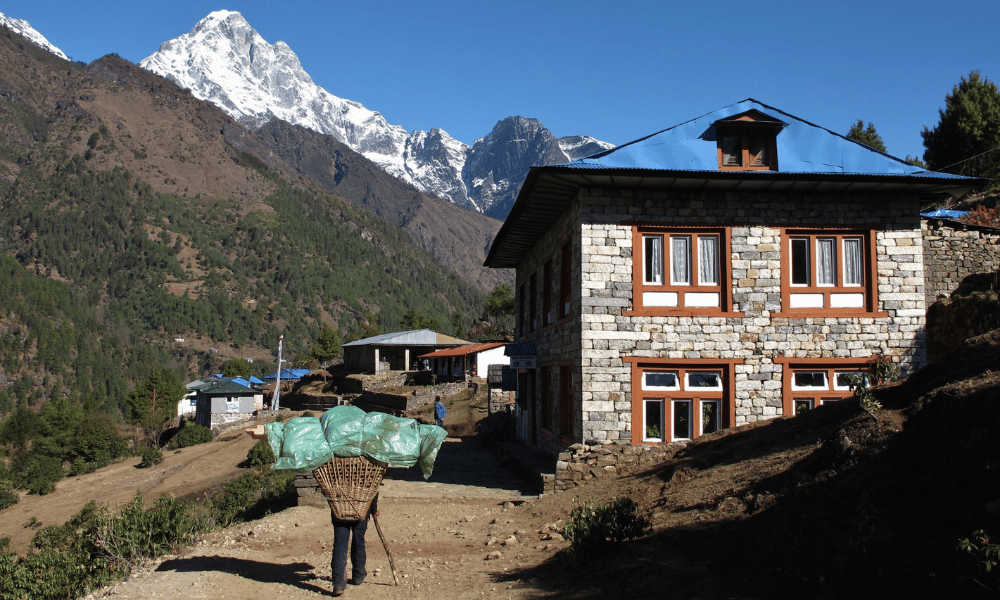
The Everest Base Camp Trek is one of the world's most famous and popular hiking trips. Trekkers go through the heart of the Khumbu region on this difficult but rewarding trip. They cross high mountain passes, deep river valleys, and beautiful Sherpa villages.
Most people take 12 to 14 days to finish the trip, which ends at the Everest Base Camp (5,364 meters) where they can look up at Mount Everest, the tallest mountain in the world. Trekkers learn about the rich Sherpa culture and get amazing views of some of the highest mountains in the world, such as Everest, Lhotse, Nuptse, and Ama Dablam.
The Gokyo Lakes Trek is an alternative route in the Everest area that takes trekkers off the beaten path to see the beautiful high-altitude scenery of the Khumbu region and the pristine Gokyo Lakes. This moderate to difficult walk usually takes 12 to 15 days to finish. It crosses the difficult but rewarding Cho La pass and gives you amazing views of the peaks in the area.
The Gokyo Lakes are the highest series of freshwater lakes in the world. They are made up of six turquoise glacial lakes. Trekkers can also walk up to Gokyo Ri, which is 5,357 meters high and has a great view of Mount Everest, Cho Oyu, Makalu, and other tall peaks in the area.
Tengboche Monastery, also called Dawa Choling Gompa, is the biggest and most important Buddhist monastery in the Khumbu region. It is at an altitude of 3,867 meters. The monastery is an important stop for trekkers going to Everest Base Camp or other places in the area. It is surrounded by the beautiful Himalayan hills.
The Shakyamuni Buddha statue and the colorful paintings on the walls of the monastery are two of its most famous features. Tengboche Monastery is a very important part of keeping the unique Sherpa culture and Buddhist customs alive in the area. Throughout the year, visitors can see different religious events and festivals, like the colorful Mani Rimdu festival, where local monks perform masked dances and other cultural acts.
As the place where Lord Buddha was born, Lumbini, a UNESCO World Heritage Site in the Terai area of Nepal, has a lot of historical and spiritual importance. When people visit the sacred gardens, temples, and monuments that honor the life and lessons of the Buddha, they can feel a deep sense of peace and spirituality. The Maya Devi Temple, which marks the exact spot where Buddha was born, and the Monastic Zone, which has many different Buddhist monasteries from different countries and styles, are two of the most popular places to visit. Lumbini is a one-of-a-kind place where visitors can get in touch with the spiritual heart of Buddhism while being in a quiet, peaceful setting.
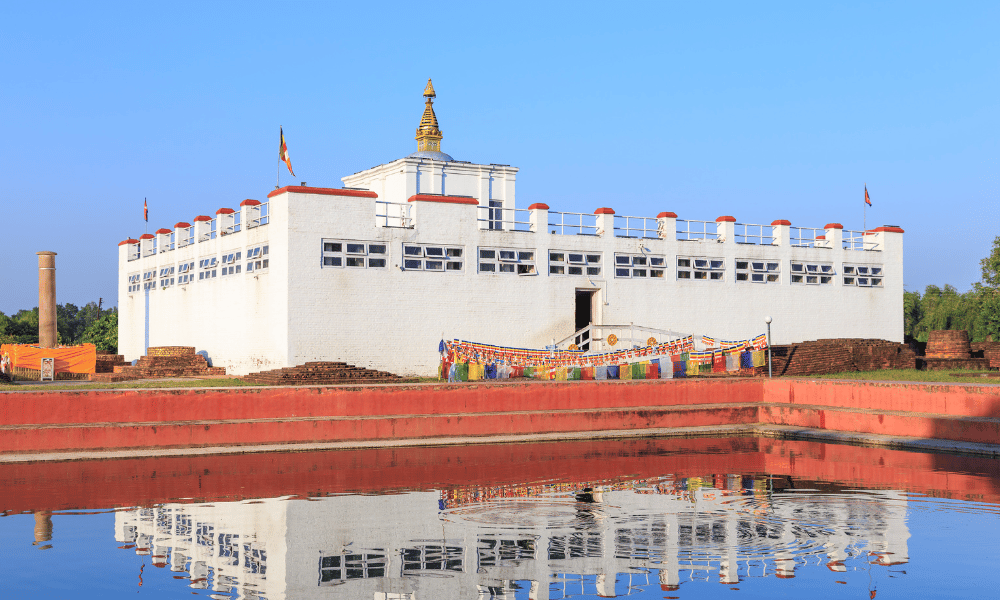
Lord Buddha, the founder of Buddhism, was born in Lumbini, which is in the Terai area of Nepal. Lumbini has a lot of historical and spiritual importance because it is one of the most important pilgrimage places for Buddhists all over the world. Lumbini was named a UNESCO World Heritage Site in 1997, which shows how important it is as a religious and cultural treasure.
When people go to Lumbini, they can feel a deep sense of spirituality and peace as they walk through the sacred gardens, temples, and statues that honor the Buddha's life and teachings.
The main draw in Lumbini is the Maya Devi Temple, which is named after Buddha's mother, Queen Maya Devi. It marks the exact spot where Lord Buddha was born in 623 B.C. The famous Nativity Sculpture is kept in the temple. It shows Queen Maya Devi holding a branch of a tree for support during the birth of Buddha, while two servants pour water and offer lotus flowers.
The holy pool, called the Puskarini Pond, is right next to the temple. This is where people think Queen Maya Devi took a bath before she gave birth to the Buddha. The temple and the sacred park around it create a quiet place for people to think and reflect, letting them connect with the spiritual heart of Lumbini.
The Monastic Zone in Lumbini is a large area that is split into two parts: the Eastern Monastic Zone, which has Theravada monasteries, and the Western Monastic Zone, which has Mahayana and Vajrayana temples. More than 25 shrines, temples, and meditation centers from China, Japan, Myanmar, Thailand, Vietnam, and other Buddhist countries can be found in the Monastic Zone.
In the monasteries, visitors can learn about different architectural types, cultural elements, and religious practices. They can also meditate, pray, or talk with the monks who live there. The Monastic Zone is a great example of how different Buddhist styles can work together in harmony. It is also a unique way to learn about the rich tapestry of Buddhism around the world.
The Langtang Region is in the middle of the Himalayas. It has a wide range of hiking opportunities that show off its beautiful scenery and rich cultural history. Trekkers can go on beautiful trips like the Langtang Valley Trek, which goes through traditional Tamang towns, or they can visit the holy Gosaikunda Lake, which is a Hindu pilgrimage site. The Tamang Heritage Trail is also a special way to learn about the culture and way of life of the local people. Langtang Region is a must-see for travelers who want an authentic and memorable trip in Nepal. It has beautiful natural scenery and lively cultural experiences.
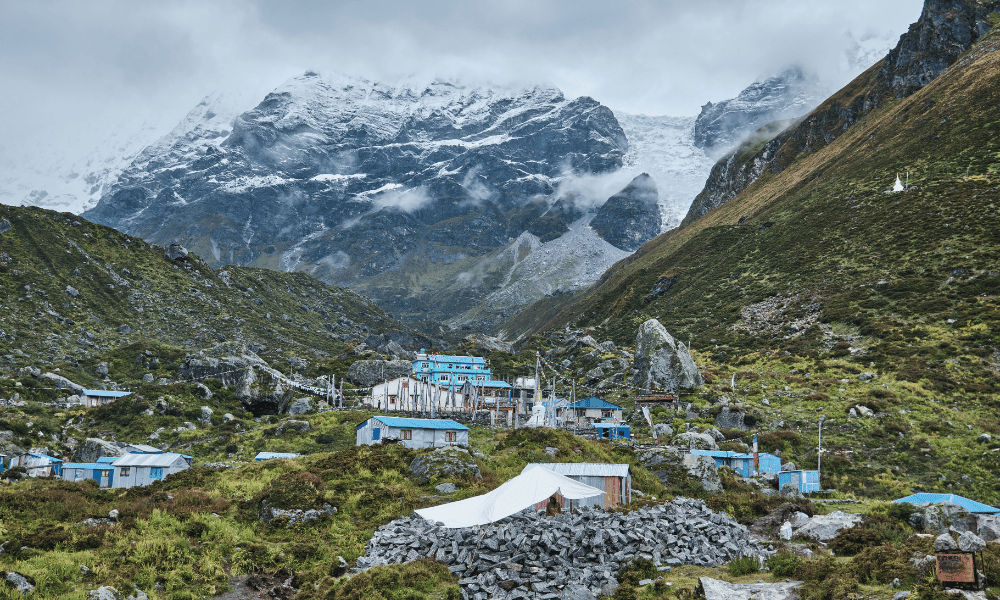
The Langtang Valley Trek is a fascinating trip that goes through the peaceful Langtang National Park. This park is home to a wide range of plants and animals, including the rare red panda. This moderate walk usually takes between 7 and 10 days and gives you a unique chance to learn about traditional Tamang culture and see beautiful Himalayan scenery.
The walk starts in the lower Langtang Valley and goes through lush forests, terraced farmlands, and charming Tamang villages. As the trail goes up, hikers get to see beautiful views of the Langtang mountain range. The trail ends at the town of Kyanjin Gompa, which is surrounded by tall snow-covered peaks.
Gosaikunda Lake, which is in the Langtang area at an elevation of 4,380 meters, is a holy travel site for Hindus. Hindu legend says that Lord Shiva made the lake when he hit a mountain with his trident to get water because he was thirsty after eating poison.
During the Janai Purnima holiday in August, thousands of Hindu pilgrims go to Gosaikunda to take a holy dip in the lake's waters, which are thought to wash away sins and bring good luck. Trekkers can join the trek to Gosaikunda Lake with the Langtang Valley Trek or the Helambu Trek for a deep cultural and spiritual experience in the Himalayas.
The Tamang Heritage Trail is a relatively new trekking path in the Langtang area. It was made to promote environmentally friendly tourism and help the Tamang communities in the area. This moderate walk usually takes between 5 and 7 days and gives trekkers a unique chance to learn about the rich culture, traditions, and way of life of the Tamang people.
The trail goes through beautiful towns, terraced farmlands, and old monasteries that show off the Tamang people's traditional architecture, handicrafts, and farming methods. Visitors can also take part in local festivals, try authentic food, and stay in local homes. This helps them learn more about the Tamang culture and appreciate it more, while also helping the local people make a living.
Tourist spots that do not get much attention in Nepal offer unique, off-the-beaten-path experiences and show off the country's hidden gems and lesser-known sights. Hill stations like Nagarkot and Dhulikhel are peaceful getaways with great views of the Himalayas. Places like Kalinchowk and Daman, which get a lot of snow, are winter wonderlands for people who love snow. Monasteries and gompas like Shey Gompa and Thubten Chholing Monastery give visitors access to remote spiritual places and a chance to learn about the rich Buddhist culture. By going to these places that are not as well known, tourists can learn more about Nepal's natural beauty and cultural history while having a more authentic and personal experience.
Nagarkot is a beautiful hill station just 32 kilometers east of Kathmandu. It is famous for its views of the Himalayas, including Mount Everest, and its beautiful sunrises and sunsets. This quiet getaway has many things to do, such as short hikes, mountain biking, and watching birds.
Dhulikhel: This charming hill station is 30 kilometers east of Kathmandu. It has a great mix of natural beauty and cultural history. There are beautiful views of the Himalayas from the town, as well as old temples and Newari architecture. Visitors can also enjoy the hiking and biking trails in the area or take part in cultural activities in the area.
Kalinchowk: Located in the Dolakha area, Kalinchowk is a less-known place that turns into a winter wonderland when it snows. The area is home to the famous pilgrimage site Kalinchowk Bhagwati Temple and has a lot of things to do, such as trekking, snowboarding, and skiing.
Daman: Located in the Makwanpur district at an elevation of 2,322 meters, Daman is an off-the-beaten-path place that is known for getting snow in the winter. The town has beautiful views of the Himalayas and is a great place for snow lovers looking for a quiet place to go.
Related Article: Snowfall Places in Nepal
Shey Gompa is a Buddhist monastery that has been there for hundreds of years. It is in the remote Dolpo area of Nepal, which is surrounded by the rough Himalayas. This secret gem can only be reached by a difficult trek. It is a great place for people who want to try new things and learn about Buddhist culture.
Thubten Chholing Monastery is an important Tibetan Buddhist monastery in the Solu-Khumbu area. It was built by the famous meditation master Trulshik Rinpoche. The Solu-Khumbu trekking path leads to the monastery, which gives visitors a unique chance to see how the resident monks live and practice their spiritual beliefs.
By visiting these lesser-known tourist spots in Nepal, visitors can learn more about the country's diverse natural beauty, rich cultural history, and lively spiritual traditions while also having a more real, off-the-beaten-path experience.
In this piece, we looked at the best places to visit in Nepal, a country with stunning natural beauty, a wide range of landscapes, a rich cultural history, and a deep spirituality. From the busy city of Kathmandu to the peaceful hill stations, from the breathtaking trekking routes in the Annapurna and Everest regions to the holy pilgrimage sites in Lumbini, Nepal has a lot to offer visitors of all interests and abilities.
As we enjoy the unique things this beautiful country has to offer, it is important to stress how important it is to be a responsible tourist. We can help protect Nepal's natural and cultural treasures for future generations by respecting local customs and traditions, having as little effect on the environment as possible, and supporting local businesses and communities.
We invite our readers to go to Nepal and see its amazing sights for themselves. Nepal is a great place to go if you want to try new things, learn about other cultures, or just get away from it all. You will come back with great memories and a better understanding of the world's beauty and diversity.
our first-hand Himalayan travel experience